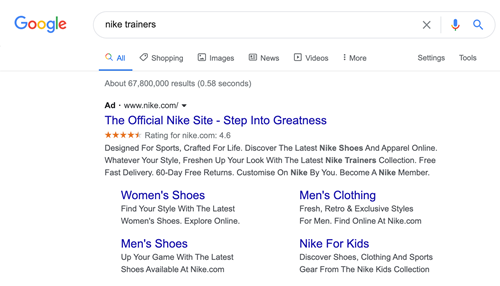Google Ads Quality Score: What Is It & Why It Matters
15 September 2020
Are you currently trying to master the art of PPC, in particular, Google Ads? If so, you have come to the right place. Don’t fall ignorant to this metric, as there’s more here than meets the eye.
To make your way to becoming a master, you need a solid understanding of the Google Ads Quality Score, a metric that has a huge influence over the cost and effectiveness of your paid search campaigns. This score will affect how your ads perform and how much you pay for each click.
Quality Score is tracked in Google AdWords and gives an estimate of the quality of your ad by giving it a score out of 10. Each keyword in your account will be assigned a quality score and it will fluctuate based on a variety of factors that change over time.
The score will be calculated each time a search is carried out that triggers your ad, but remember it can take time to achieve any improvements in your account. When adding new keywords, the default score when a campaign is created is 7 and it is very likely this will change over time. So don't be fooled by this number at the start!
Google states the following:
Many confuse Quality Score and Ad Rank as they both seem like Google’s way of evaluating your campaigns, but they are not the same. Quality Score is a tool to help advertisers improve campaigns and can inform them on how to adjust campaigns accordingly to achieve maximum results. Whereas Ad Rank is Google’s way of taking into account more in-depth campaign information to determine where your ad will be positioned in SERPs.
Google uses the Quality Score to show more relevant ads to users every time a search happens because they depend on revenue from advertising (around 70.9% of their revenue stream comes from it) which means they need to find a way to ensure the ads are interesting to users so they click through.
Using low-quality ads would waste space that could be filled with more relevant ads, Google then wouldn’t make as much money and could even risk alienating its users in the long term.
Many advertisers may see the Quality Score metric as a struggle to overcome, but it is in fact there to help drive those high-quality leads to a site, something everyone expects to achieve from using Google Ads. If advertisers are picking the relevant keywords and combining that with compelling ad copy, it will lead to big wins and reduced CPCs.
It’s no secret that Google has a wealth of data about how users interact with their search results, and they use this data alongside machine learning techniques to come up with a measure of the expected relevance of every keyword, landing page, and ad relative to every search that happens.
So rather than going through their employees asking them to judge keyword relevance, they use their algorithms to monitor what users interact with, and so Quality Score is produced.
Quality score is affected by three major factors:
As a marketer, you will already know the importance of copy, and copy used in your ads will have an impact on your quality score. This is because relevance is important for Google to provide the best results to users. Take a look at the below example for Nike trainers.

When writing copy, the keyword you are targeting needs to be in both title and the ad itself, without overstuffing. Keep in mind that you need to write ad copy that is going to appeal to both search engines and users. Thankfully, Google will let you know that your ad isn’t as relevant as it could be, which gives you the opportunity to play around with wording until you get it right.
Another consideration used by Google to determine ad quality score is the landing page linked to your ad. Google will look at the relevance of the content on the landing page, as well as page load speed. By sending traffic to relevant landing pages, your quality score will increase.
When searchers arrive on your landing page, are they going to be happy they did or are they going to bounce right back to the search results? Landing pages used in ads need to relate to what the user searched for and deliver on the promise in the ad. Often, linking to specific landing pages is better than taking someone to your homepage.
In the Nike example, users can click straight through to the homepage, or can choose from one of the four given sitelink extension options: Women's, Men's or Kids Shoes and Men’s Clothing:

The final key consideration with landing page choice is that it needs to be easy to use on both mobile and desktop devices. As we mentioned pages need to load fast, and sometimes using an accelerated mobile page (AMP) can help this. Here is an example of how Nike has adapted the Women's Shoes landing page for mobile:


Click through rates of your ad will have a huge impact on the quality score you receive. Google uses CTRs as a way of understanding how relevant and appropriate your ad is to meeting the search intent of a user.
Expected click through rates will vary depending on where the ad is positioned, so if your ad is displayed at the top of a results page Google will expect it to have a higher click through rate than those ads at the bottom of results pages.
Trying to improve click through rates can be challenging as there are only a limited number of clicks up for grabs.
As an advertiser working to optimise and improve your Google Ad Quality Score, you will set your business or client up for a higher return on investment. This can be achieved by focusing efforts on the following key areas:
Devote time to keyword research to discover new and relevant terms to add to campaigns, including those long-tail keyword opportunities that can contribute to the bulk of your traffic. From there, organise keywords into tight groups which can then be more effectively tied to ad campaigns.
We previously mentioned that ad copy is important, and testing out what works best for individual ad groups will ensure you’re achieving the best possible results. Higher CTRs is ultimately one of the best ways to improve your quality score.
Research and identify irrelevant search terms that are wasting your budget and add those to your negative keywords. This allows you to focus on the keywords that matter most to your customers, and deciding on which keywords not to target is a key component of any highly targeted campaign.
By having a good quality score, Google will be more likely to show your ads and rank them well. Good scores can be just as beneficial as high bids, and even those ads with lower bids can beat major competitors simply because their ads are more relevant to search intent. It’s not always the big players that win!
Of course, it’s worth optimising those low ad quality scores, but don’t get too hung up on it or you will lose track of what’s really important - making connections with new potential prospects.
Are you currently struggling with your Google Ads and paid search efforts? Here at Loud Mouth Media, our team of PPC experts can help take your ads to the next level. To find out more about Google Ads or any of our other services, get in touch now to speak with our team.